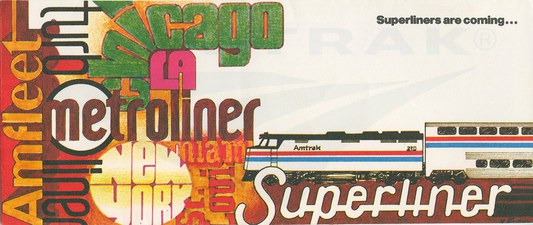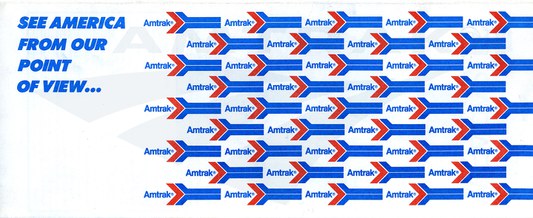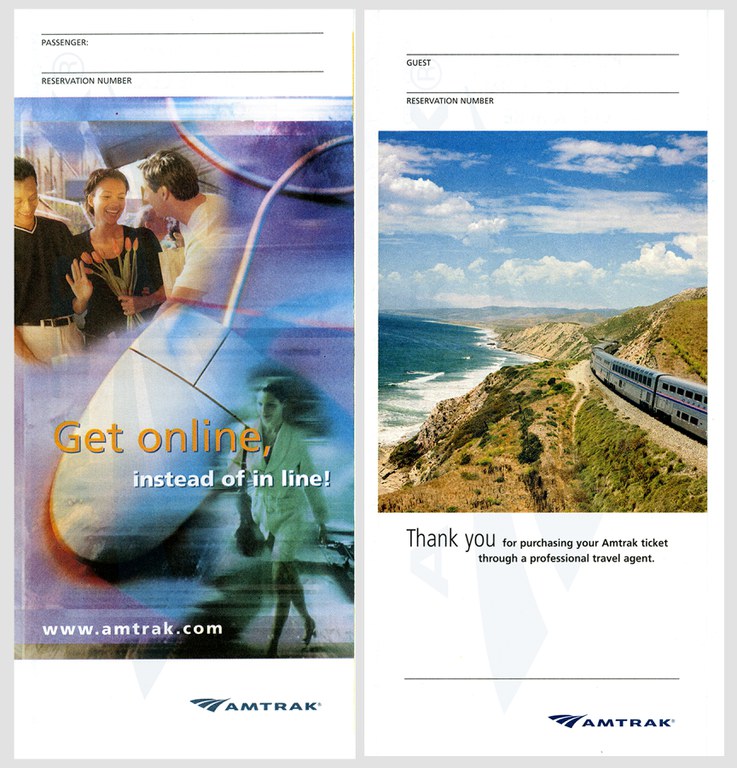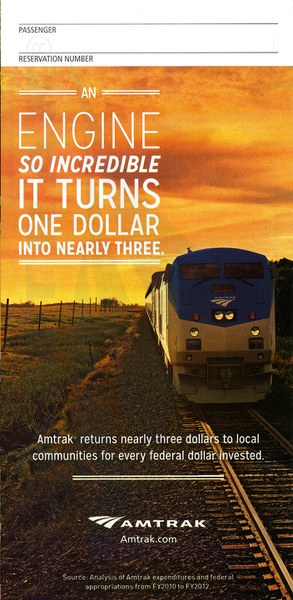A Closer Look: The Ticket Jacket
CommentsAugust 29, 2014
Part of organizing material donated to the Amtrak Archives simply involves grouping like things together, such as timetables, advertisements and equipment photos. This is a useful exercise because it often helps us see items in a new light—you begin to recognize patterns or common motifs that connect objects. This recently occurred when we organized ticket jackets, the paper folders into which a ticket agent places your tickets for safekeeping.
At the end of their journey, most people probably throw the jacket away without a second thought. And in the age of eTicketing, many passengers never receive a ticket jacket in the first place, but rather print tickets at home or show a QR code on their smartphone for the conductor to scan. Perhaps in a few years’ time, the jackets and paper tickets will simply be pieces of railroad history from the pre-digital era.
Laid out together on a table, the jackets’ colorful imagery provides a mini-history of Amtrak over the past four decades. The company uses the front panel to tout customer service initiatives, highlight new equipment and showcase stunning scenery along various routes. Inside, the panels usually include an explanation of refund and baggage policies and other travel essentials. There’s also space for the ticket agent to pencil in your train number, car number, departure date and time and final destination. Sometimes there are advertisements for Amtrak merchandise or goods offered by outside vendors, such as discounts to a museum or show. Below we take a look at some of the jackets and the stories they reveal:

Dating from the late 1970s, this jacket tantalizes with the phrase “Superliners are coming….” In its first decade, Amtrak concentrated on overhauling and replacing the fleet of cars and locomotives it had purchased or leased from the predecessor railroads. Amtrak rebuilt the best of the older cars and converted them to electric head-end power; interiors were modernized with vibrant color schemes including combinations of orange, red and purple.
Orders were quickly placed for new single-level Amfleet cars and gas-turbine powered Turboliner train sets. In 1973, an Amtrak team started designing the bi-level Superliner cars that first entered service on western long-distance routes six years later. The jacket includes a drawing of a Superliner car in the Phase III paint scheme from 1979.

Issued in 1982, this jacket uses the first Amtrak service mark as the building block for a larger, dazzling geometric design. The service mark was developed for Amtrak by the marketing firm Lippincott & Margulies, Inc. According to a press release issued on April 19, 1971, “Key elements in the new [Amtrak] corporate identity program are crisp, modern graphics and a distinctive, motion-oriented, service mark in the national colors…Eventually [it] will be used as the design motif for passenger car exteriors and interiors…” In 2000, the company unveiled the current blue service mark that also imparts a sense of movement through flowing lines.

The growth of the internet in the 1990s transformed the way businesses interact with their customers. Amtrak embraced this new communication platform by launching Amtrak.com in 1995; by 2000, it had become one of the most bookmarked sites on the web. This ticket jacket (above left) from 2002 shows a young couple picking out tulips at a market, perhaps because they saved time by buying their tickets online instead of going to a station or travel agent.
Building upon the success of Amtrak.com, the company launched eTicketing across the national system in 2012. It allows passengers to print their tickets at their convenience or use a smartphone to show the eTicket to the conductor, thereby resulting in shorter ticket lines at stations, fewer tickets sold onboard trains and a decrease in the number of lost tickets. The eTicket program also provides Amtrak with accurate real time knowledge of who is on the train, en route reporting of onboard equipment problems and more efficient financial reporting.

This jacket from 2001 (above right) draws you in with a gorgeous photograph that, judging by the landscape, probably shows the Coast Starlight in California. Rolling hills recede into the distance as waves break onto shore down below, creating foamy whitecaps. The route of the Coast Starlight is often considered one of the most scenic, offering views of wildflower meadows, the Cascade Range and Puget Sound.
Sleeping car passengers can enjoy the scenery from one of the bi-level Pacific Parlour cars, which were originally built in the mid-1950s for the Atchison, Topeka and Santa Fe Railway. Due to their popularity, they served as the model for the Superliners. Amtrak refurbished the Pacific Parlour cars in the mid-1990s to provide a casual, yet elegant, space for Sleeping car passengers to relax. Passengers can enjoy an intimate meal upstairs, a movie in the onboard theater or play a board game.
Photography is again effectively employed to draw the viewer’s attention to the cover of this recently-issued ticket jacket. Against a warm, golden orange sky, a cross country train passes through an open landscape. The latter reminds passengers that intercity rail service connects not only major urban areas, but also small and medium-sized communities, many of which lack other forms of public transportation. Messaging in the top left hand corner highlights the economic impact of Amtrak service on local communities through goods and services purchased and wages paid to employees.
Do you collect Amtrak ticket jackets or ticket stubs? Tell us about one that holds special meaning for you in the comments section below.




